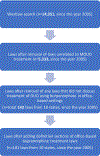Toward a Typology of Office-based Buprenorphine Treatment Laws: Themes From a Review of State Laws
- PMID: 34014209
- PMCID: PMC8599526
- DOI: 10.1097/ADM.0000000000000863
Toward a Typology of Office-based Buprenorphine Treatment Laws: Themes From a Review of State Laws
Abstract
Objectives: Buprenorphine is a gold standard treatment for opioid use disorder (OUD). Some US states have passed laws regulating office-based buprenorphine treatment (OBBT) for OUD, with requirements beyond those required in federal law. We sought to identify themes in state OBBT laws.
Methods: Using search terms related to medications for OUD, we searched Westlaw software for state regulations and statutes in 51 US jurisdictions from 2005 to 2019. We identified and inductively analyzed OBBT laws for themes.
Results: Since 2005, 10 states have passed a total of 181 OBBT laws. We identified the following themes: (1) provider credentials: state licensure for OBBT providers and continuing medical education requirements; (2) new patients: objective symptoms patients must have before receiving OBBT and exceptions for special populations; (3) educating patients: general informed consent requirements, and specific information to provide; (4) counseling: minimum counselor credentials, minimum counseling frequency, counseling alternatives; (5) patient monitoring: required prescription drug monitoring checks, frequency of drug screening, and responses to lost/stolen medications; (6) enhanced clinician monitoring: evidence-based treatment protocols, minimum clinician-patient contact frequency, health assessment requirements, and individualized treatment planning; and (7) patient safety: reconciling prescriptions, dosage limitations, naloxone coprescribing, tapering, and office closures.
Conclusions: Some laws codify practices for which scientific consensus is lacking. Additionally, some OBBT laws resemble opioid treatment programs and pain management regulations. Results could serve as the basis for a typology of office-based treatment laws, which could facilitate empirical examination of policy impacts on treatment access and quality.
Copyright © 2021 American Society of Addiction Medicine.
Conflict of interest statement
The authors report no conflicts of interest.
Figures
Comment in
-
Commentary: Moving Toward Clear, Evidence-based, and Effective State Policies for Addiction Medicine.J Addict Med. 2022 Mar-Apr 01;16(2):130-131. doi: 10.1097/ADM.0000000000000862. J Addict Med. 2022. PMID: 34014208
Similar articles
-
Laws for expanding access to medications for opioid use disorder: a legal analysis of 16 states & Washington D.C.Am J Drug Alcohol Abuse. 2022 Jul 4;48(4):492-503. doi: 10.1080/00952990.2022.2082301. Epub 2022 Jun 30. Am J Drug Alcohol Abuse. 2022. PMID: 35772010 Free PMC article.
-
A Systematic Review of State Office-Based Buprenorphine Treatment Laws Effective During 2022: Counseling, Dosage, and Visit Frequency Requirements.Subst Use Addctn J. 2024 Apr;45(2):278-291. doi: 10.1177/29767342231223721. Epub 2024 Jan 30. Subst Use Addctn J. 2024. PMID: 38288697
-
Beyond state scope of practice laws for advanced practitioners: Additional supervision requirements for buprenorphine prescribing.J Subst Abuse Treat. 2022 Jul;138:108715. doi: 10.1016/j.jsat.2021.108715. Epub 2022 Jan 10. J Subst Abuse Treat. 2022. PMID: 35067400 Free PMC article.
-
Buprenorphine prescribing for opioid use disorder in medical practices: can office-based out-patient care address the opiate crisis in the United States?Addiction. 2019 Nov;114(11):1992-1999. doi: 10.1111/add.14733. Epub 2019 Jul 25. Addiction. 2019. PMID: 31307111 Free PMC article.
-
Thematic Analysis of State Medicaid Buprenorphine Prior Authorization Requirements.JAMA Netw Open. 2023 Jun 1;6(6):e2318487. doi: 10.1001/jamanetworkopen.2023.18487. JAMA Netw Open. 2023. PMID: 37318805 Free PMC article. Review.
Cited by
-
Association of Selected State Policies and Requirements for Buprenorphine Treatment With Per Capita Months of Treatment.JAMA Health Forum. 2023 May 5;4(5):e231102. doi: 10.1001/jamahealthforum.2023.1102. JAMA Health Forum. 2023. PMID: 37234015 Free PMC article.
-
Barriers and facilitators to scaling up medications for opioid use disorder in Kentucky: qualitative perspectives of treatment organization staff.Subst Abuse Treat Prev Policy. 2025 Apr 2;20(1):15. doi: 10.1186/s13011-025-00644-y. Subst Abuse Treat Prev Policy. 2025. PMID: 40176107 Free PMC article. Clinical Trial.
-
Will the End of the X-Waiver Expand Access to Buprenorphine Treatment? Achieving the Full Potential of the 2023 Consolidated Appropriations Act.Subst Abus. 2023 Jul;44(3):108-111. doi: 10.1177/08897077231186212. Epub 2023 Sep 7. Subst Abus. 2023. PMID: 37675897 Free PMC article.
-
Expert Panel Consensus on State-Level Policies to Improve Engagement and Retention in Treatment for Opioid Use Disorder.JAMA Health Forum. 2022 Sep 2;3(9):e223285. doi: 10.1001/jamahealthforum.2022.3285. JAMA Health Forum. 2022. PMID: 36218944 Free PMC article.
-
Laws for expanding access to medications for opioid use disorder: a legal analysis of 16 states & Washington D.C.Am J Drug Alcohol Abuse. 2022 Jul 4;48(4):492-503. doi: 10.1080/00952990.2022.2082301. Epub 2022 Jun 30. Am J Drug Alcohol Abuse. 2022. PMID: 35772010 Free PMC article.
References
-
- Substance Abuse and Mental Health Services Administration. Medications for Opioid Use Disorder TIP 63 Treatment Improvement Protocol For Healthcare and Addiction Professionals, Policymakers, Patients, and Families. Subtance Abuse & Mental Health Services Administration;2018. - PubMed
Publication types
MeSH terms
Substances
Grants and funding
LinkOut - more resources
Full Text Sources
Other Literature Sources
Medical



